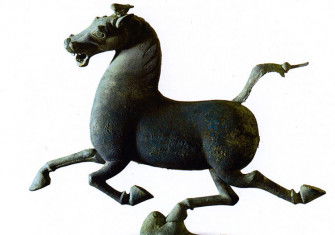Horse Power
Exploring Paris, city of horses.

In the West, the 19th century was a frenetic one for the horse, which became ubiquitous and democratised, fetishised and consumed in multiple senses. Industrialisation and urbanisation required an army of equids, while leisure equestrianism opened up to a larger audience. Mass entertainment such as circuses, hippodromes, racing and the theatrical spectacles known as hippodramas put the horse literally centre stage. In art and literature, new and varied depictions of horses built on centuries of symbolic and aesthetic representations. Christian countries began to eat horse meat openly for the first time in a millennium. And in Paris, the ‘capital’ of that century, horses became enmeshed in the anxieties about shifting class, gender and race that Kari Weil details in the seven essays of Precarious Partners.
Each of Weil’s essays circles one subject – the painters Théodore Géricault and Rosa Bonheur; pity at the public abuse of horses; horsemeat; the equestrian stuntwomen Adah Isaacs Menken; the aristocratic amateurs’ circus run by Ernest Molier; the social psychology of Gustav Le Bon – but they exist in a constellation of ideas and connections that run the gamut from Jacques Derrida to Orientalism, ontological choreography, queer ecology, George Sand and plans to send camels to Brazil. The result is a rich and sophisticated analysis that uses materials from literary fiction to fine art, ephemera and philosophy. No sooner is one complex thread of thought teased out than Weil reveals another intertwined strand that loops back in contraposition.
One chapter, ‘Purebreds and Amazons’, deals with women’s assault on the previously male bastion of, well, horsemanship, as women in life, art and literature put their riding skills and hippophilia on display, whether in the Bois de Boulogne or in the circus ring. The response is torn between a sexualisation of these women with their crops and riding habits on muscled mounts and a fear that these ‘amazones’ emasculated both men and the horse. From Zola to the Brothers Goncourt, horsey women were frequently conflated with the animals themselves and the act of riding to sex, with weakened Frenchmen used up and left behind.
Weil looks in detail at the performer Adah Isaacs Menken, adding a further dimension of race: an American of creole background who recast herself as Jewish, wore blackface and played male roles while dressed in skimpy ‘fleshings’ and strapped to the back of a ‘wild’ horse, Menken racked up so many cumulative transgressions that she drove the French imagination haywire. She was caricatured canoodling with her horse and even as a centauress in African dress and hooped earrings, both drooled over and compared unfavourably to white Frenchwomen. The misogyny was creative; fear that the French ‘race’, and men in particular, had become degraded was real.
This fed into efforts to restore that masculinity and national muscularity. In 1880, a unique private circus was founded by the wealthy (and bourgeois) Ernest Molier in his Paris townhouse. The male performers were moneyed and aristocratic amateurs; the women performers were professionals; the audience made up of more wealthy and aristocratic men and their demi-mondaine mistresses. The circus provided a paradoxical laundering effect: homoeroticism was both staved off and enabled – a fact not missed by the artist James Tissot in his painting ‘The Circus Lover’ – and the men, playing at fencing, acrobatics and dressage, showed off their disciplined bodies just like the girl acrobats in tutus on roisinbacks. ‘Cirque Molier’ divided opinion neatly into those who thought it further degraded the French male and those who were ‘charmed by the resurrection of muscle in the ruling classes’, as the Paris Journal wrote. The spectacle of eugenics looms over these discussions, with the breeding and ‘perfection’ of humans repeatedly compared with the breeding of horses.
At a few points I would have liked more of a grounding as a lay reader. I couldn’t grasp St Simonianism, a mystical social movement into which Rosa Bonheur was born, for example, and wished there was more space for the ways in which Weil connects so many ideas to 20th-century phenomena and attitudes. The last essay is perhaps the most challenging, moving from 18th-century animal magnetism to 21st-century equestrianism, where the ‘precarious partnership’ between human and equine is ‘threatened on both sides, whether by resistance, by miscommunication, or by breach of trust’, as Weil puts it. From 19th-century Paris to the 21st the same philosophical questions resound: how should we treat animals? What is natural or innate? Are we just animals after all, and if so, what are our souls and theirs?
Precarious Partners: Horses and their Humans in Nineteenth-Century France
Kari Weil
Chicago 240pp £16.99
Susanna Forrest’s latest book is The Age of the Horse: An Equine Journey through Human History (Atlantic, 2016).






